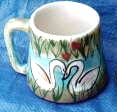Since liquid latex is the easiest material to get your hands on, I thought I'd go into more detail on making a mold with it.
For this practise, we'll take on a simple, flat sided object. Something most likely to be hung on the wall or added into a shadow box.
The reason for choosing a flat backed object, is simply that it's so very simple to perform. Probably a good place to start, if you've never played with liquid latex or making molds of any kind.
If you have something like a wall plaque, it's a good practise piece. If not, try forming something with modeling clay, leaving the back of it flat.
You'll need a small working board. Something a little wider than your model and as smooth as possible. A piece of plastic window material, a tile, something like that. You will need a smooth paint brush as well as an acid brush (one of those small ones you find at the hardware store. The handle is metal) Get some acetone (hardware store or paint dept.) for cleaning your brushes. A pint or quart of liquid latex. You will need some plaster to form a mother mold. If your object is only about the size of a biscuit, a cup of plaster will do.
You can usually find liquid latex at the craft supply stores. Some, not all, ceramic supplies that carry a wide variety of supplies for both the poured ceramics and the pottery supplies, carry the liquid latex. If you can't find a supply nearby, try online.
A fresh supply of liquid latex should look off white and the consistancy of pudding. When not using it, close the lid tightly. It's best if kept in a tight glass jar.
There is little need to apply any sort of separator to the model. If the model happens to be rough wood or very dry plaster, you might want to give it a very thin coat of vaseline.
Lay your model in the center of your working board and apply the first coat of latex. Very thinly, at first. Then as the coats of latex build up, you might start applying a little thicker coat each time.
The trick is to let each coating dry enough to actually be set (not sticky to the touch) but not dry enough to be tough, before applying the next coat. Usually, a thin coating is ready for another layer, in about 30 minutes. Keep applying another coat, letting each layer dry, until it's built up to about 1/8" then let it dry overnight.
Before pulling the mold and model off the working board, you need a mother mold. The easiest way to mix plaster to its hardest form, in very small amounts, is to first pour your water (about 1/3 the volume you think you'll need. Begin slowly sifting in the plaster until it stands just above the surface of the water. You'll notice the plaster becomes saturated and then appears to crack on the surface. It's ready for mixing. You can simply mix (whip) with a spoon for about 3 minutes and then begin to spoon it onto the rubber mold. As it begins to set up, you can form it like icing on a cake, into a box like form, slightly wider both ways, than your mold. I'd say a width of about 1/2" wider all the way around, is sufficient. Before it's had time to become rigid, smooth the top of your mound to make it a flat surface, as this will be the bottom of your mold unit, when it comes time to pour materials into the mold for reproduction.
When the plaster is set up, twist the whole unit off the working board, turn it over and let it finish setting up until the plaster has completely cooled down.
With a sponge, wash back any plaster that has seeped around the edge of your rubber mold, preventing it from just dropping out. Grab the edges of your rubber mold with finger tips and gently pull the rubber mold out of the mother mold.
Once that is done, remove the rubber mold from your model. Now you can sponge down your mother mold and wash the rubber mold. Replace the rubber mold back into its mother mold for safe keeping.
When your ready to pour something like plaster into your mold, rinse your mold in soapy water and just shake off the excess. Then pour your plaster into the mold. The soap will rise quickly, bringing with it any bubbles formed in the plaster.
The soapy solution should be about the same as a pan of dish water. No more soap than that.
For simple objects, like wall plaques, you can use pottery plaster (plaster of paris), mixed very densely. For things like incense burners or trivets or highly detailed figurines, I suggest using hydrocal. Hydrocal is pure white, not as hard as hydrostone but certainly harder the pottery plaster and you can mix it very densely for a non-porous stone-like material.
Just a note of caution. Liquid latex is not suitable for pouring resins.



